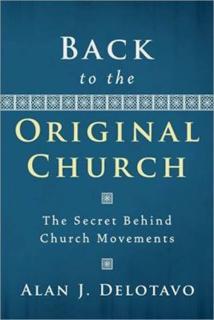Alan Delotavo’s Back to the Original Church, reviewed by Jim Williams
From Pneuma Review Fall 2013.
 Alan J. Delotavo, Back to the Original Church: The Secret Behind Church Movements (Eugene, OR: Resource Publications, 2010), 100 pages, 9781556355660.
Alan J. Delotavo, Back to the Original Church: The Secret Behind Church Movements (Eugene, OR: Resource Publications, 2010), 100 pages, 9781556355660.
Regular and careful Bible readers inevitably piece the Bible story together until they have a sense of the grand sweep of things. We do the same with the history of the church. Sometimes unconsciously, we jump from the Book of Acts directly to Martin Luther, then to Azusa Street, and finally to the present day. Delotavo fills in some of the blanks to draw out a valuable lesson that can only be seen from an overview.
Back to the Original Church is Delotavo’s University of Pretoria ThD thesis in popular form. This conversation about the flow and progress of church history calls us to see church movements as gifts to the wider church restoring something neglected and not stopping points or ends in themselves.
Delotavo provides examples of church movements that attempted to restore an essential part of church life or faith, but which became bogged down to the point of needing their own renewal. The Reformation era focused on the recovery of the gospel in view of accumulated abuses and theological “defects.” This gospel recovery included the teaching of “the priesthood of the believer,” that each Christian had direct access to God without the need of clergy. Delotavo points out that this set up a division between laity and Protestant clergy and also spawned a divisive spirit throughout the Reformation. Further splits occurred till today denominations around the world number into the thousands. The Lutheran church became State church (protected by law and supported by taxes) and fell into the sorry state of doctrinal correctness with experiential coldness. The Reformation had become an end in itself. To recover what was needed, Pietism arose about a century later. This was an attempt to bring vital Christian experience, including conversion, assurance and holiness back into the Lutheran state church. Once more the renewal movement, although truly helping many, lost its way. Splitting many ways, some parts impacted world missions and future movements, other parts become theologically liberal, and still other parts become radical or revolutionary.
Delotavo’s excellent point bogs down, however, in historical omissions and stretches. He jumps directly from the early church to the Reformation period. The era of the main church councils (AD 325—787) he considered a breakdown of Christianity due to political connections to the Roman Empire. The “Dark Ages” or better, the medieval church, is thought to have no value. He sees the church largely pursuing the expansion of Christian civilization at the expense of “genuine experience of salvation.” Delotavo seems to ignore that in the West, the church was living through the crushing of the Roman Empire under “barbarian” invasions; that in the East, Constantinople was rising to power as the new center of the Roman Empire; and that Islam was racing across North Africa, into Spain and southern France. He could have pulled examples of church movements from these periods that prove his point, but he did not. Does he not recognize the value of that period of the church’s life?
The way forward for Delotavo is found in American Evangelicalism. He noted that several awakenings or revivals had occurred in American history from colonial times, each a church movement in itself. By the end of the nineteenth century, modern Liberalism rapidly set in resulting in the backlash of Fundamentalism in the early twentieth century. In its original form, Fundamentalism was truly a church movement to recover much that was being lost; however, it degenerated into anti-intellectualism and a belligerent separatism. In the 1940s, a corrective movement, Evangelicalism, arose to call the church back to theological basics, to academic engagement, and to a loving spirit. Here, Delotavo believes, is the apex of church movements, breaking down all barriers, and penetrating all denominations and traditions. Here is what the church was meant to be at last! Delotavo forgets his own warning: church movements are means to an end (renewal for the entire church) not ends in themselves (the final best expression of the church). Is this the climax of church history?
Category: Church History, Fall 2013


